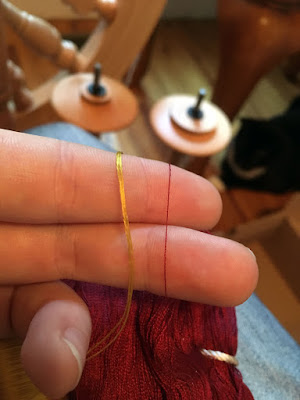As a follow-up to my jury-rigged bobbin winding system, and to avoid looking at the fact that I got no weaving and very little embroidery done over the weekend, I thought I'd talk about how I wound the bobbin of tripled thread to use as my brocading weft.
 |
| I adore these colors together. |
That photo is actually about halfway through the process. You can see that a single strand of the gold thread is a bit thicker than the red, but for brocading wefts it's nice to have three or four times the thickness of the structural weft to ensure the pattern stands out clearly against the ground weave.
 |
| Hey, you can't see the funnel spider inhabiting my windowsill from here! |
There are easier ways to wind up thread multiples, including winding as many separate bobbins as you want strands in your final product and then winding all of them together in one swell foop. I didn't do that, because I
was suffering from temporary insanity had forgotten the bobbins that came with my wheel would do just as well for holding yarn. Instead, I put the hank on my swift and wound onto one bobbin, then put that bobbin into my trusty shoebox bobbin holder and paired the thread with the end coming off the hank, and wound both onto a second bobbin. Same process again to triple the thread. And then:
 |
| AUGH. And other, ruder words. |
Desastre. The downside to not using a flyer (to avoid putting twist where none is wanted) and therefore having a knitting needle for the bobbin axle is that sometimes bobbin and needle make a leap for freedom. And the swift is spinning merrily along, and so is the auxiliary bobbin, and so is the free-falling bobbin-axle assembly as it disintegrates into its component parts. It's okay if that makes no sense. There're a lot of spinny things happening and none of them are good.
I spent about 20 minutes very carefully unwinding and untangling and rewinding threads after I took that photo, and said rude things to the cat who was being Very Interested over my shoulder and around my side.
 |
| Not quite there... |
Doubled gold thread was nearly thick enough for me to be happy with it against the red, but I like dense designs, and it doesn't hurt anything to be enthusiastic about weighting the brocading thread more.
 |
| Just call me Rumpelstiltskin. |
Tripled thread felt right (and I was tired of coaxing the thread to wind nicely by then, too). I did have a bit of shift in the threads, from slightly different wrapping locations building up different total lengths, but I'll smooth them out as I wind shuttles to weave.





Comments
Post a Comment